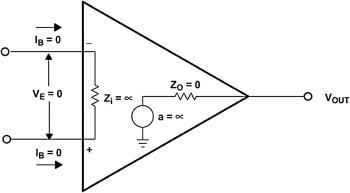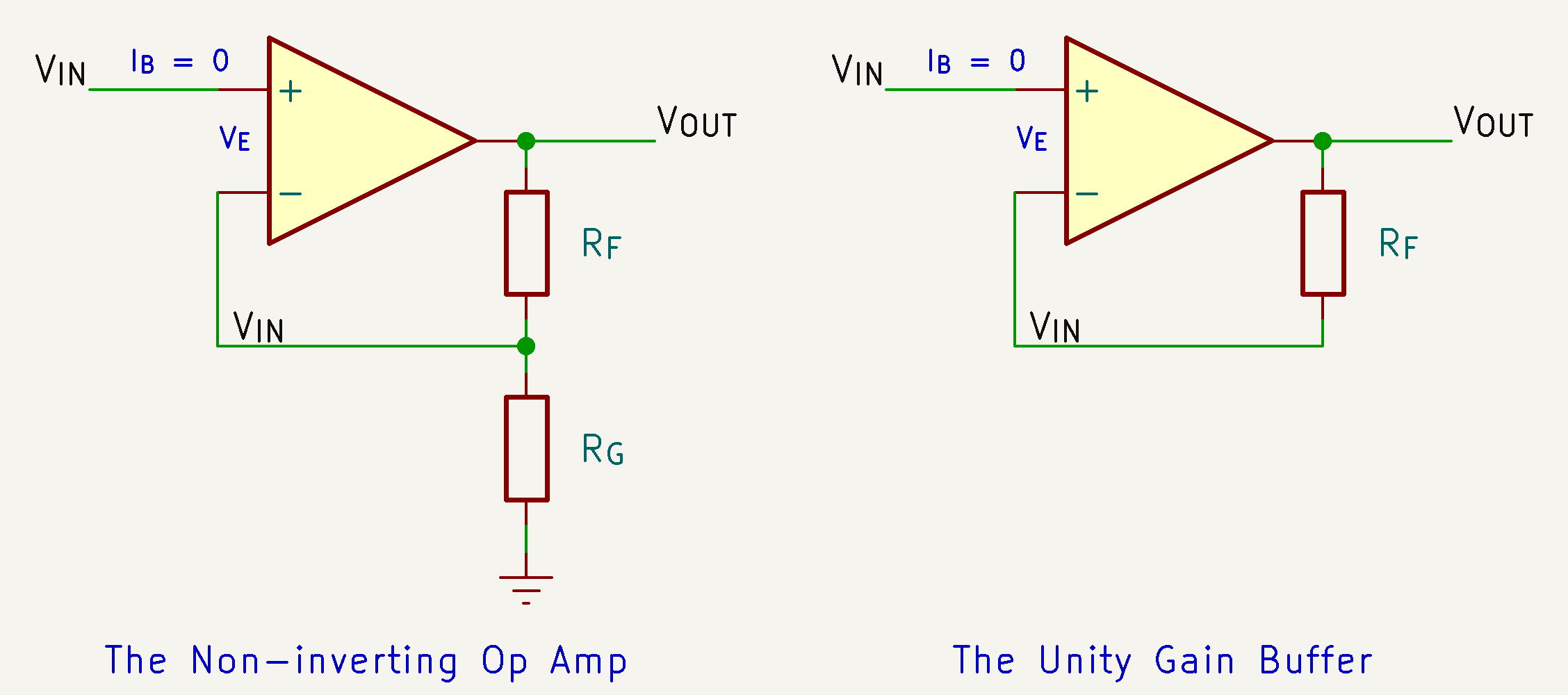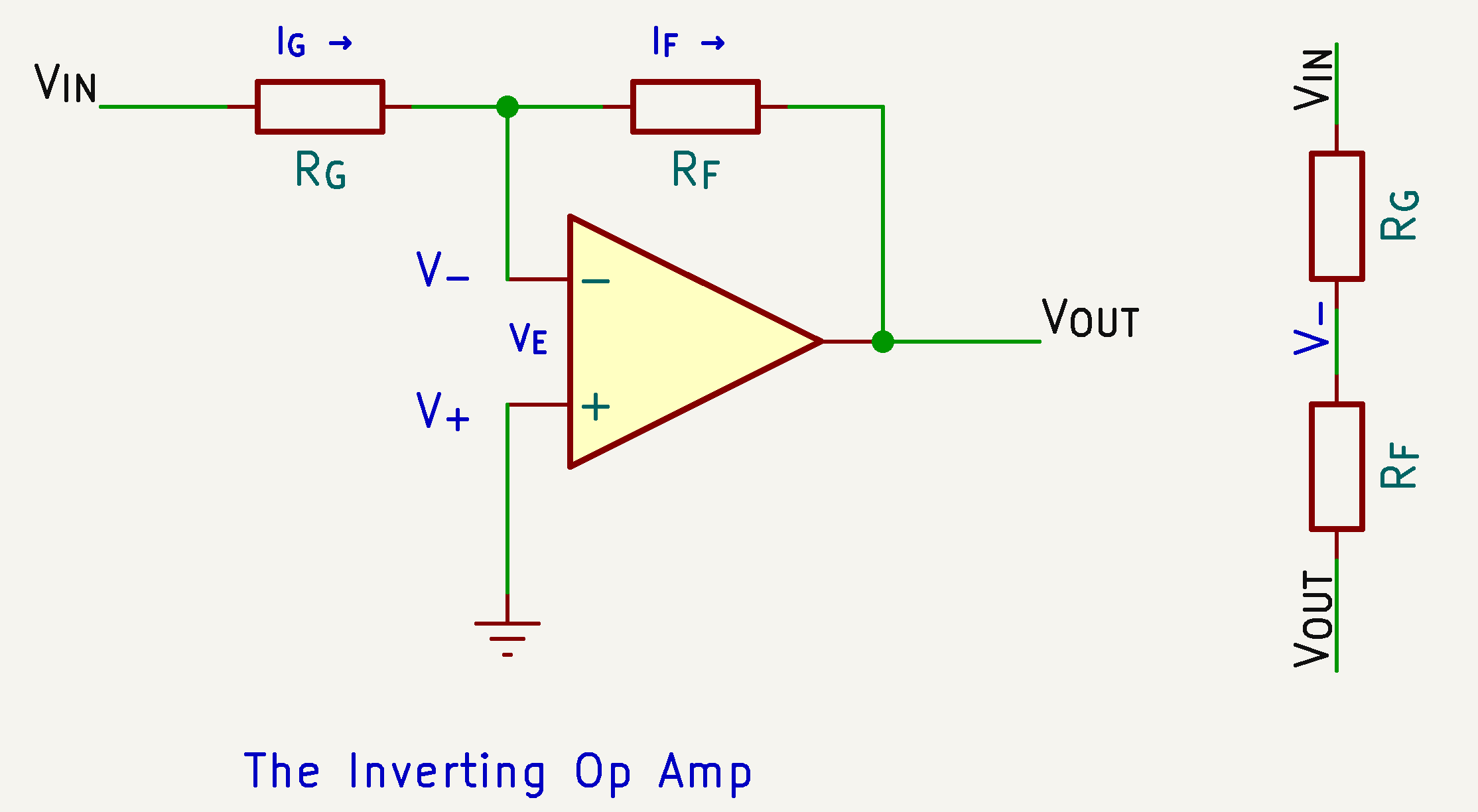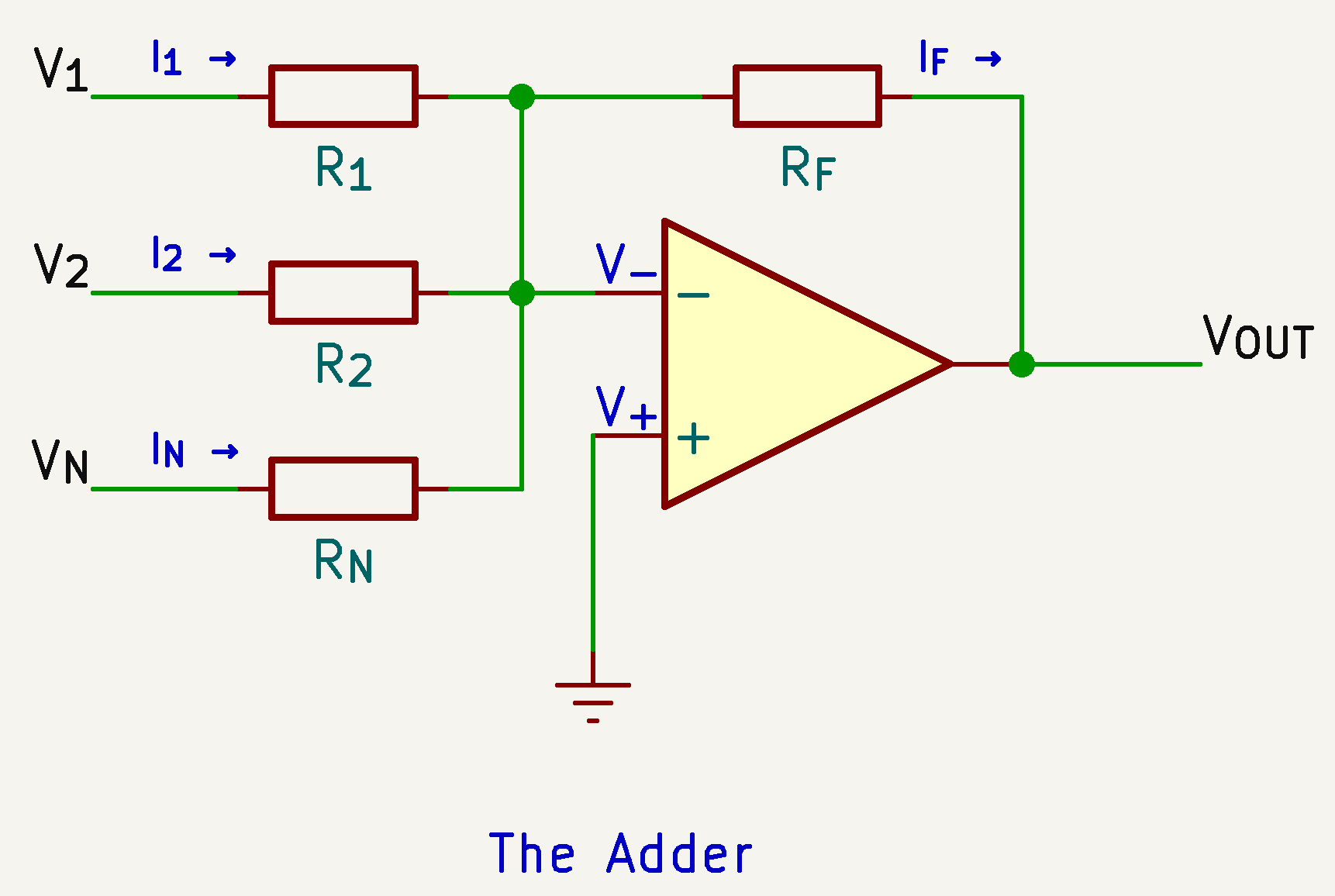Op Amps for Everyone Notes
Chapter 2 - Development of the Ideal Op Amp Equations
Ideal Op Amp

| Parameter | Value |
|---|---|
| $I_{\text{IN}}$ - Input current | 0 |
| $V_{\text{OS}}$ - Input offset voltage | 0 |
| $Z_{\text{IN}}$ - Input impedance | $\infin$ |
| $Z_{\text{OUT}}$ - Outage impedance | 0 |
| $a$ - Gain | $\infin$ |
From Wikipedia - Operational Amplifier:
- Infinite open-loop gain $G = v_{\text{out}} / v_{\text{in}}$
- Infinite input impedance $R_{\text{in}}$, and so zero input current
- Zero input offset voltage
- Infinite output voltage range
- Infinite bandwidth with zero phase shift and infinite slew rate
- Zero output impedance $R_{\text{out}}$, and so infinite output current range
- Zero noise
- Infinite common-mode rejection ratio (CMRR)
- Infinite power supply rejection ratio.
The Non-inverting Op Amp

$$ \begin{align} V_{\text{OUT}} &= A_{\text{OL}}(V_{+} - V_{-}) \cr V_{-} &= \frac {R_{\text{G}}} {R_{\text{F}} + R_{\text{G}}} V_{\text{OUT}} = \beta V_{\text{OUT}} \end{align} $$
Substituting this into the gain equation, we obtain
$$ \begin{align} V_{\text{OUT}} &= A_{\text{OL}}(V_{\text{IN}} - \beta V_{\text{OUT}}) \end{align} $$
Solving for out $V_{{\text{OUT}}}$:
$$ \begin{align} V_{\text{OUT}} &= V_{\text{IN}} \left(\frac {1} {\beta + \displaystyle \frac {1} {A_{\text{OL}}}} \right) \end{align} $$
If $A_{\text{OL}}$ is vary large (100,000 or more), this simplifies to
$$ \begin{align} V_{\text{OUT}} \approx {\frac {V_{\text{IN}}}{\beta }} &= {\frac {V_{\text{IN}}}{\frac {R_{\text{G}}}{R_{\text{F}}+R_{\text{G}}}}}=V_{\text{IN}}\left(1+{\frac {R_{\text{F}}}{R_{\text{G}}}}\right) \cr \frac {V_{\text{OUT}}}{V_{\text{IN}}} &= \left(1+{\frac {R_{\text{F}}}{R_{\text{G}}}}\right). \end{align} $$
When $R_{\text{G}}$ becomes very large, $\displaystyle \frac {R_{\text{F}}}{R_{\text{G}}} \implies 0$, the circuit becomes a unity gain buffer.
$$ \frac {V_{\text{OUT}}}{V_{\text{IN}}} = 1 $$
- $R_{\text{G}} = \infin$ - Usually removed.
- $R_{\text{F}}$ is used to protect the inverting input from overvoltage.
The Inverting Op Amp

$$ \begin{align} V_{\text{OUT}} &= A_{\text{OL}}(V_{+} - V_{-}) \end{align} $$
$V_{-}$ is a function to $V_{\text{IN}}$ and $V_{\text{OUT}}$ due to $R_{\text{F}}$ and $R_{\text{G}}$.
$$ \begin{align} \frac{V_{\text{IN}}-V_{\text{OUT}}}{R_{\text{G}}+R_{\text{F}}} = \frac{V_{-}-V_{\text{OUT}}}{R_{\text{F}}} \cr V_{-} = \frac{R_{\text{G}}V_{\text{OUT}}+R_{\text{F}}V_{\text{IN}}}{R_{\text{G}}+R_{\text{F}}} \end{align} $$
Substituting this into the gain equation, we obtain
$$ \begin{align} V_{\text{OUT}} &= -A_{\text{OL}}\frac{R_{\text{G}}V_{\text{OUT}}+R_{\text{F}}V_{\text{IN}}}{R_{\text{G}}+R_{\text{F}}} \cr (R_{\text{G}}+R_{\text{F}})V_{\text{OUT}} &= -A_{\text{OL}}{R_{\text{G}}V_{\text{OUT}}-A_{\text{OL}}R_{\text{F}}V_{\text{IN}}} \cr V_{\text{OUT}} &= -V_{\text{IN}} \frac{A_{\text{OL}}R_{\text{F}}}{A_{\text{OL}}R_{\text{G}}+R_{\text{G}}+R_{\text{F}}} \end{align} $$
If $A_{\text{OL}}$ is vary large (100,000 or more), this simplifies to
$$ \begin{align} V_{\text{OUT}} &= -V_{\text{IN}} \frac{R_{\text{F}}}{R_{\text{G}}} \cr \frac{V_{\text{OUT}}}{V_{\text{IN}}} &= -\frac{R_{\text{F}}}{R_{\text{G}}} \end{align} $$
The Adder

The non-inverting input is grounded, so the inverting input is virtually ground, there is no current flow through the inputs
$$ \begin{align} I_{\text{F}} &= I_{\text{1}} + I_{\text{2}} + I_{\text{N}} \cr \frac{0 - V_{\text{OUT}}}{R_{\text{F}}} &= \frac{V_{\text{1}}}{R_{\text{1}}} + \frac{V_{\text{2}}}{R_{\text{2}}} + \frac{V_{\text{N}}}{R_{\text{N}}} \cr V_{\text{OUT}} &= - \left(\frac{R_{\text{F}}}{R_{\text{1}}}V_{\text{1}} + \frac{R_{\text{F}}}{R_{\text{2}}}V_{\text{2}} + \frac{R_{\text{F}}}{R_{\text{N}}}V_{\text{N}} \right) \end{align} $$
The Differential Amplifier

$$ \begin{align} V_{+} &= V_{\text{1}}\frac{R_{\text{2}}}{R_{\text{1}}+R_{\text{2}}} \cr \frac{V_{\text{OUT}}-V_{2}}{R_{\text{3}}+R_{\text{4}}} &= \frac{V_{-} - V_{\text{2}}}{R_{\text{3}}} \cr V_{\text{OUT}} &= V_{-}\frac{R_{\text{3}}+R_{\text{4}}}{R_{\text{3}}}- V_{\text{2}} \frac{R_{\text{4}}}{R_{\text{3}}} \cr \end{align} $$
Consider $V_{+} = V_{-}$, we have
$$ \begin{align} V_{\text{OUT}} &= V_{\text{1}}\frac{R_{\text{3}}+R_{\text{4}}}{R_{\text{3}}} \frac{R_{\text{2}}}{R_{\text{1}}+R_{\text{2}}} - V_{\text{2}}\frac{R_{\text{4}}}{R_{\text{3}}} \cr \end{align} $$
If the resisters $R_{\text{1}} = R_{\text{3}}$ and $R_{\text{2}} = R_{\text{4}}$, this simplifies to
$$ \begin{align} V_{\text{OUT}} &= (V_{\text{1}} - V_{\text{2}})\frac{R_{\text{2}}}{R_{\text{1}}} = (V_{\text{1}} - V_{\text{2}})\frac{R_{\text{4}}}{R_{\text{3}}} \end{align} $$